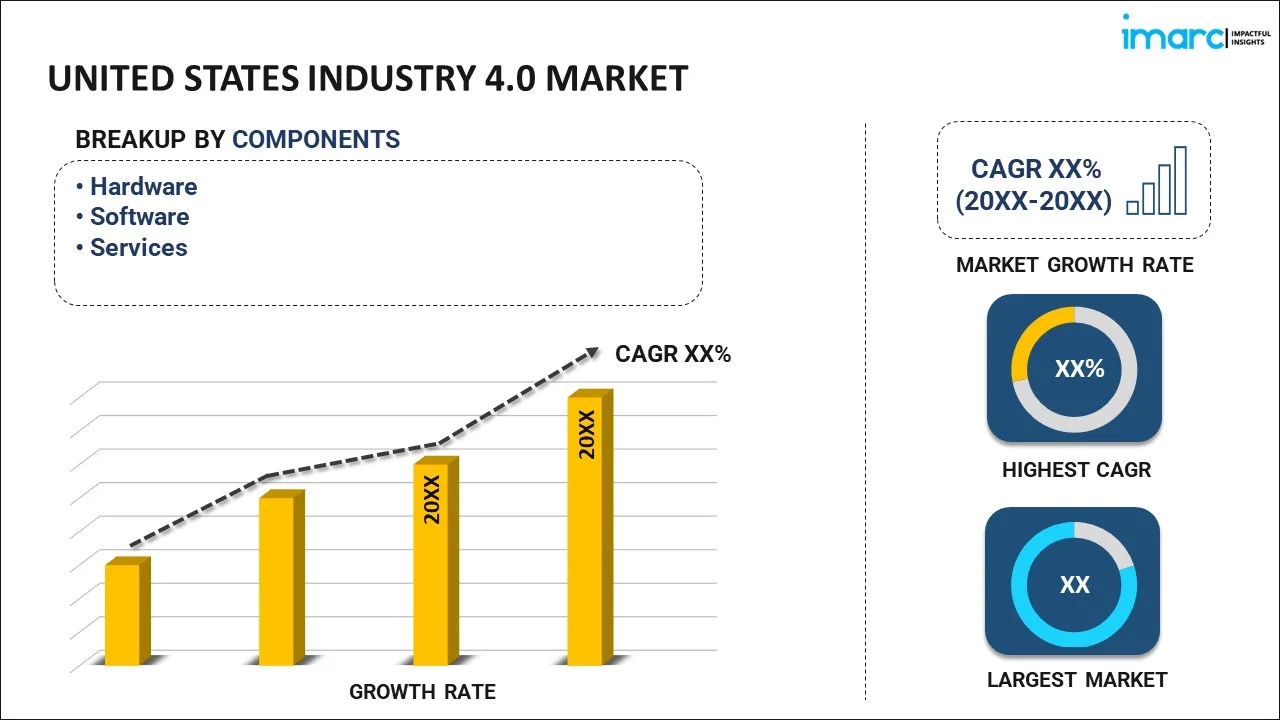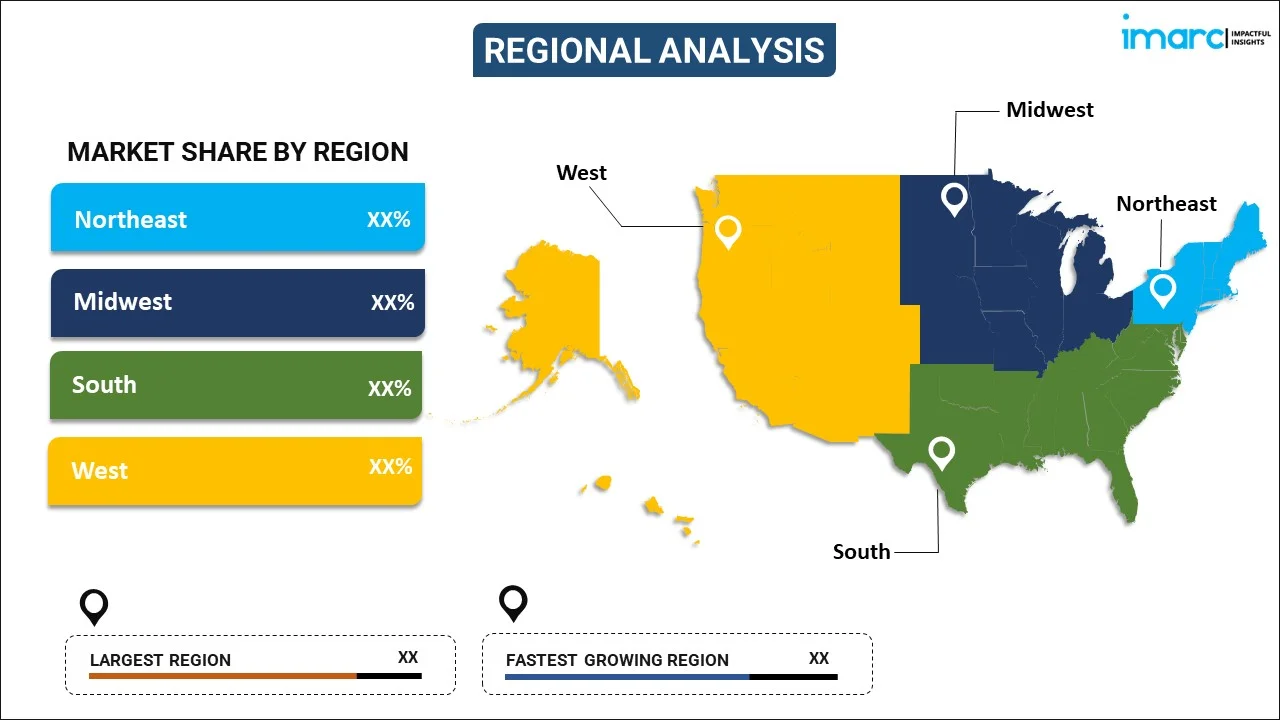
United States Industry 4.0 Market Report by Component (Hardware, Software, Services), Technology Type (Industrial Robotics, Industrial IoT, AI and ML, Blockchain, Extended Reality, Digital Twin, 3D Printing, and Others), End Use Industry (Manufacturing, Automotive, Oil and Gas, Energy and Utilities, Electronic and Foundry, Food and Beverages, Aerospace and Defense, and Others), and Region 2025-2033
Market Overview:
United States industry 4.0 market size is projected to exhibit a growth rate (CAGR) of 19.54% during 2025-2033. The advancements in technology, the widespread adoption of the Internet of Things (IoT), the rise of artificial intelligence (AI) and machine learning (ML), a growing emphasis on sustainability, the expansion of fifth-generation (5G) technology, the impact of the COVID-19 pandemic, and government support for innovation are bolstering the market growth.
|
Report Attribute
|
Key Statistics
|
|---|---|
|
Base Year
|
2024 |
|
Forecast Years
|
2025-2033 |
|
Historical Years
|
2019-2024
|
| Market Growth Rate (2025-2033) | 19.54% |
Industry 4.0, often referred to as the fourth industrial revolution, represents a transformative paradigm shift in manufacturing and industrial processes. It is characterized by the integration of digital technologies into various aspects of production, leading to enhanced automation, data-driven decision-making, and improved efficiency. At its core, Industry 4.0 is made possible through the convergence of technologies such as the Internet of Things (IoT), artificial intelligence (AI), big data analytics, and advanced robotics. These technologies work in tandem to create interconnected and smart production systems. Sensors and devices embedded within machinery and equipment collect vast amounts of data, which is then analyzed in real-time to optimize processes. The advantages of Industry 4.0 are numerous, such as it improves operational efficiency, reduces production costs, and enhances product quality. With the ability to monitor and control processes remotely, it also supports a more flexible and agile manufacturing environment. Furthermore, data-driven insights enable better strategic decision-making and resource allocation. Currently, industry 4.0 encompasses smart manufacturing, agriculture (smart farming), healthcare (telemedicine), and smart cities for enhanced infrastructure management.
United States Industry 4.0 Market Trends:
The United States industry 4.0 market is influenced by several key drivers, such as advancements in technology and automation that are revolutionizing industrial processes. Automation and the integration of digital technologies are enhancing productivity and efficiency across various industries, from manufacturing to logistics. This is further supported by the increasing adoption of the Internet of Things (IoT). IoT enables the connection of devices and equipment, facilitating data collection and analysis. This real-time data empowers businesses to make informed decisions, optimize operations, and reduce downtime. Moreover, the proliferation of artificial intelligence (AI) and machine learning is fueling the market growth. AI-driven algorithms can analyze vast amounts of data to identify patterns and trends, helping businesses predict maintenance needs, optimize supply chains, and enhance product quality. Additionally, the growing emphasis on sustainability and eco-friendliness has compelled businesses to incorporate green technologies, such as energy-efficient machinery and sustainable materials, to align with environmental goals and meet regulatory requirements, which is accelerating the market growth. Apart from this, the COVID-19 pandemic has highlighted the importance of remote operations and digitalization, which is stimulating the market growth in the country.
United States Industry 4.0 Market Segmentation:
IMARC Group provides an analysis of the key trends in each segment of the market, along with forecasts at the country level for 2025-2033. Our report has categorized the market based on component, technology type, and end use industry.
Component Insights:

- Hardware
- Software
- Services
The report has provided a detailed breakup and analysis of the market based on the component. This includes hardware, software, and services.
Technology Type Insights:
- Industrial Robotics
- Industrial IoT
- AI and ML
- Blockchain
- Extended Reality
- Digital Twin
- 3D Printing
- Others
A detailed breakup and analysis of the market based on the technology type have also been provided in the report. This includes industrial robotics, industrial IoT, AI and ML, blockchain, extended reality, digital twin, 3D printing, and others.
End Use Industry Insights:
- Manufacturing
- Automotive
- Oil and Gas
- Energy and Utilities
- Electronic and Foundry
- Food and Beverages
- Aerospace and Defense
- Others
The report has provided a detailed breakup and analysis of the market based on the end use industry. This includes manufacturing, automotive, oil and gas, energy and utilities, electronic and foundry, food and beverages, aerospace and defense, and others.
Regional Insights:

- Northeast
- Midwest
- South
- West
The report has also provided a comprehensive analysis of all the major regional markets, which include Northeast, Midwest, South, and West.
Competitive Landscape:
The market research report has also provided a comprehensive analysis of the competitive landscape in the market. Competitive analysis such as market structure, key player positioning, top winning strategies, competitive dashboard, and company evaluation quadrant has been covered in the report. Also, detailed profiles of all major companies have been provided.
United States Industry 4.0 Market Report Coverage:
| Report Features | Details |
|---|---|
| Base Year of the Analysis | 2024 |
| Historical Period | 2019-2024 |
| Forecast Period | 2025-2033 |
| Units | Million USD |
| Scope of the Report | Exploration of Historical Trends and Market Outlook, Industry Catalysts and Challenges, Segment-Wise Historical and Future Market Assessment:
|
| Components Covered | Hardware, Software, Services |
| Technology Types Covered | Industrial Robotics, Industrial IoT, AI and ML, Blockchain, Extended Reality, Digital Twin, 3D Printing, Others |
| End Use Industries Covered | Manufacturing, Automotive, Oil and Gas, Energy and Utilities, Electronic and Foundry, Food and Beverages, Aerospace and Defense, Others |
| Regions Covered | Northeast, Midwest, South, West |
| Customization Scope | 10% Free Customization |
| Post-Sale Analyst Support | 10-12 Weeks |
| Delivery Format | PDF and Excel through Email (We can also provide the editable version of the report in PPT/Word format on special request) |
Key Questions Answered in This Report:
- How has the United States industry 4.0 market performed so far and how will it perform in the coming years?
- What has been the impact of COVID-19 on the United States industry 4.0 market?
- What is the breakup of the United States industry 4.0 market on the basis of component?
- What is the breakup of the United States industry 4.0 market on the basis of technology type?
- What is the breakup of the United States industry 4.0 market on the basis of end use industry?
- What are the various stages in the value chain of the United States industry 4.0 market?
- What are the key driving factors and challenges in the United States industry 4.0?
- What is the structure of the United States industry 4.0 market and who are the key players?
- What is the degree of competition in the United States industry 4.0 market?
Key Benefits for Stakeholders:
- IMARC’s industry report offers a comprehensive quantitative analysis of various market segments, historical and current market trends, market forecasts, and dynamics of the United States industry 4.0 market from 2019-2033.
- The research report provides the latest information on the market drivers, challenges, and opportunities in the United States industry 4.0 market.
- Porter's five forces analysis assist stakeholders in assessing the impact of new entrants, competitive rivalry, supplier power, buyer power, and the threat of substitution. It helps stakeholders to analyze the level of competition within the United States industry 4.0 industry and its attractiveness.
- Competitive landscape allows stakeholders to understand their competitive environment and provides an insight into the current positions of key players in the market.
Need more help?
- Speak to our experienced analysts for insights on the current market scenarios.
- Include additional segments and countries to customize the report as per your requirement.
- Gain an unparalleled competitive advantage in your domain by understanding how to utilize the report and positively impacting your operations and revenue.
- For further assistance, please connect with our analysts.
 Inquire Before Buying
Inquire Before Buying
 Speak to an Analyst
Speak to an Analyst
 Request Brochure
Request Brochure
 Request Customization
Request Customization




.webp)




.webp)












